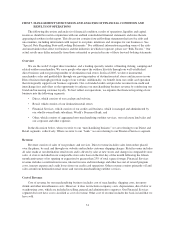Cabela's 2005 Annual Report Download - page 37
Download and view the complete annual report
Please find page 37 of the 2005 Cabela's annual report below. You can navigate through the pages in the report by either clicking on the pages listed below, or by using the keyword search tool below to find specific information within the annual report.government regulators or VISA could unilaterally increase their minimum capital requirements. Also, we have
significant potential obligations in the form of the unused credit lines of our cardholders. As of the end of fiscal
2005, these unfunded amounts were approximately $7.5 billion. Draws on these lines of credit could materially
exceed predicted line usage. In addition, the occurrence of certain events, such as significant defaults in payment
of securitized loans or failure to comply with the terms of securitization covenants, may cause previously
completed securitization transactions to amortize earlier than scheduled or be reclassified as a liability for
financial accounting purposes, both of which would have a significant effect on our ability to meet the capital
maintenance requirements of our bank subsidiary, as affected off-balance sheet loans would immediately be
recorded on our consolidated balance sheet and would be subject to regulatory capital requirements. If any of
these factors occur, we may have to contribute capital to our bank subsidiary, which may require us to raise
additional debt or equity capital and/or divert capital from our direct and retail businesses, which in turn could
significantly alter our destination retail store expansion strategy.
It may be difficult to sustain the historical growth and profitability of our financial services business,
and we will be subject to various risks as we attempt to grow the business.
We may not be able to retain existing cardholders, grow account balances or attract new cardholders and the
profits from our financial services business could decline, for a variety of reasons, many of which are beyond our
control, including:
• credit risk related to the loans we make to cardholders and the charge-off levels of our credit card
accounts;
• lack of growth of potential new customers generated by our direct and retail businesses;
• liquidity and funding risk relating to our ability to create the liquidity necessary to extend credit to our
cardholders and provide the capital necessary to meet the requirements of government regulators and
VISA; and
• operational risk related to our ability to acquire the necessary operational and organizational
infrastructure, manage expenses as we expand, and recruit management and operations personnel with
the experience to run an increasingly complex and highly-regulated business.
Economic downturns and social and other factors could cause our credit card charge-offs and
delinquencies to increase, which would decrease our profitability.
Economic downturns generally lead to increased charge-offs and credit losses in the consumer finance
industry, which would cause us to experience increased charge-offs and delinquencies in our credit card loan
portfolio. An economic downturn can hurt our financial performance as cardholders default on their balances or
carry lower balances. A variety of social and other factors also may cause changes in credit card use, payment
patterns and the rate of defaults by cardholders. These social factors include changes in consumer confidence
levels, the public’s perception of the use of credit cards, changing attitudes about incurring debt and the stigma of
personal bankruptcy. Additionally, credit card accounts tend to exhibit a rising trend in credit loss and
delinquency rates between 18 to 30 months after they are issued. If the rate of growth in new account generation
slows, the proportion of accounts in the portfolio that have been open for between 18 to 30 months will increase
and the percentage of charge-offs and delinquencies may increase. Our underwriting criteria and product design
may be insufficient to protect the growth and profitability of our financial services business during a sustained
period of economic downturn or recession or a material shift in social attitudes, and may be insufficient to protect
against these additional negative factors.
The performance of our financial services business may be negatively affected by the performance of
our merchandising businesses.
Negative developments in our direct and retail businesses could affect our ability to grow or maintain our
financial services business. We believe our ability to maintain cardholders and attract new cardholders is highly
25
























